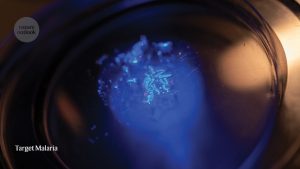
The elimination of malaria presents a challenge for scientists
Vaccination for the Plasmodium falciparum parasite by means of antibodies from sporozoites: The first malaria field trial in Africa
Despite such obstacles, there are reasons to be hopeful. Researchers are making progress in devising ways to prevent and treat this complex parasitic disease. The major advance of the past few years was the arrival of the first vaccine for malaria. RTS,S is being rolled out to children in a handful of countries in Africa, with more hoping to benefit soon. There is still room for improvement. Some of the alternatives to the vaccine for the Plasmodium falciparum parasites are different at different points in its life cycle. There is a need for vaccines to be used against other species. Some researchers hope that monoclonal antibodies could offer another route to protection. Others are looking at ways to eradicate the mosquito that brings the parasites and possibly using a gene drive to do so.
After working on making a vaccine for Malaria, it became clear that there might be limitations to their ability to provide high level protection in all age groups. The aim of malaria vaccines is to help the host develop a strong immune response to the parasite, but their efficacy can vary according to age and previous malaria exposure. Monoclonal antibodies aren’t dependent on the body mounting a response of its own — the only variable is the amount required for protection.
RS: The first antibody that we isolated was CIS43, from people who had taken part in a prior vaccine trial that I had overseen. This binds a protein that is highly conserved on the sporozoite form of the Plasmodium falciparum parasite, which is what mosquitoes deliver when they bite people. Our antibody fights off the sporozoites before they travel to the liver. Its usefulness is limited by the short half-life of antibodies, which is only about 21 days. The LS was added to create CIS 43LS. This allows the antibody to last around 60–80 days.
This was the first field trial against seasonal transmission. Intravenous administration allowed us to use a relatively high dose to demonstrate that we could achieve protective efficacy in adults. Dosages of antibodies are based on a person’s weight, so for young children we can deliver a protective dose by subcutaneous or intramuscular injection instead. The ultimate goal is to give injections of the monoclonal antibodies in adults too.
Kassoum Kayentao: Even if we don’t have a monoclonal antibody that can be given subcutaneously, intravenous administration is still useful for certain populations. One dose given to a pregnant woman during a scheduled check-up early on in pregnancy should be enough to provide protection until birth.
Use cases of L9LS to monitor and manage severe disease: a key focus on developing a global infrastructure to improve quality of life in endemic countries
We can focus on commercial production when we get greater potency. The ultimate goal is to build manufacturing facilities in endemic countries to control costs and ensure global equity.
Babies, children, pregnant women and others who are at risk of developing severe disease are some of the major clinical use cases that we are looking at. We will look at the entire community eventually. The first phase III trial of L9LS will target those under five years old.
We could also use antibodies alongside other interventions. If you want to use the antibodies for a long time, you could choose to use it every year until your child is four years old. I think we need to be very open minded. The data coming out over the next few years will tell us how to use it.
No More Japan and Ehime University: A View from the World’s Largest Malaria Research Funding Organizations in the 21st Century
We would like to acknowledge the financial support of Ehime University (PROS) and Medicines for Malaria Venture. No More Japan with funding from the Bill & Melinda Gates Foundation, Sumitomo Chemical, GHIT Fund and Eiken Chemical, in producing this Outlook. As always, Nature retains sole responsibility for all editorial content.
A lack of money is one of the long standing obstacles to progress. The recommended funding for the control of malaria was more than double what was estimated and was projected to reach $7.3 billion by the year 2030. With the world dealing with the economic shocks of the COVID-19 pandemic and the war in Ukraine, it is hard to imagine that this funding gap will be plugged soon. Other challenges are just beginning. Drugs based on artemisinin, which kill malaria parasites, are among the world’s best weapons against the disease. But these drugs are showing signs of losing their efficacy in Africa, which is home to 95% of cases. Malaria may be spread to new parts of the world because of climate change.

